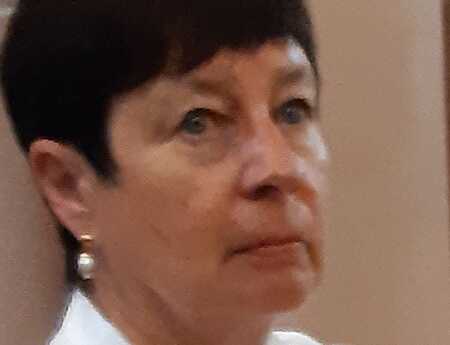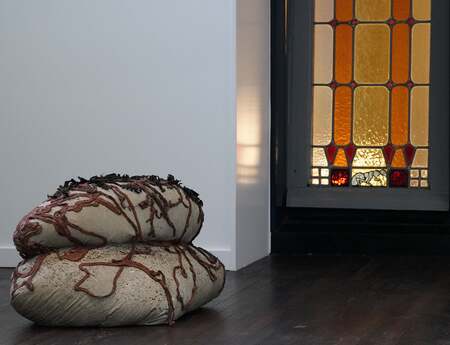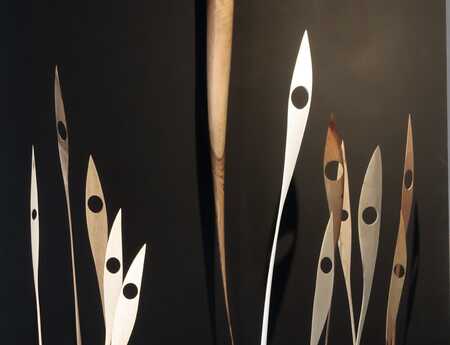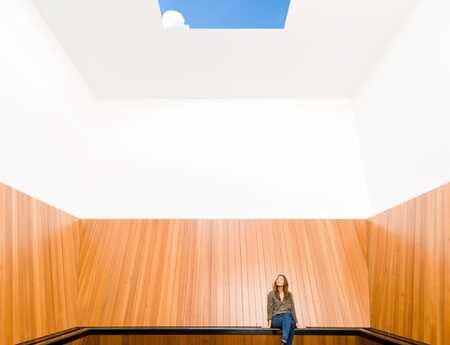100 YEARS OF BAUHAUS
A meaningful year is drawing to a close. The most influential modern art academy, the Bauhaus, celebrated its 100th birthday. Numerous exhibitions, events, lectures, performances, plays, guided tours, and workshops around the Bauhaus period revived the three Bauhaus sites Weimar, Dessau, and Berlin on the 100th anniversary year.
After Weimar opened its new Bauhaus Museum in April, the gates to the new museum in Dessau were opened in September. Our guest author Ursula Karpowitsch visited Dessau and explains in the following article what she experienced there up close.
It is astonishing to realize that the BAUHAUS existed for 14 years, had to move twice, struggled with financial problems and political issues, and yet created a global impact when "global" was not yet on everyone's lips. More than 1,250 students from 29 countries contributed to this, as did the forced exile of Walter Gropius, its founder in 1919, and Mies van der Rohe. It was "Staatliches Bauhaus" in Weimar, "Hochschule für Gestaltung" in Dessau and a private educational institution in Berlin. But regardless of name and location, the BAUHAUS was a new art school that tried to unite life and work under one roof and sought to follow Gropius' motto "Art and technology - a new entity!’’.
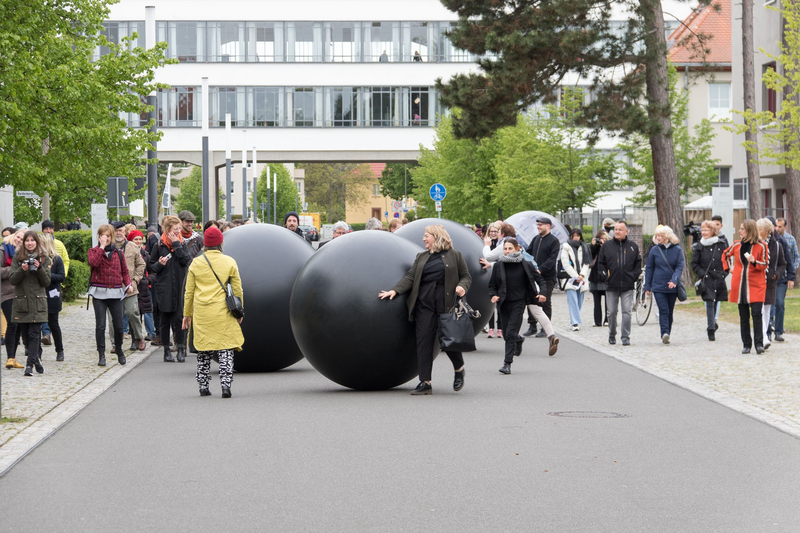
Dessau was an up-and-coming industrial city when the BAUHAUS moved there in 1925. Many personalities from politics and business supported the school, including Hugo Junkers, one of the most important engineers and entrepreneurs of the 20th century. But the acceptance of teachers and students was also high among the population. People liked these "weird birds" and their festivals were legendary. They worked together with around 100 companies from Dessau, were represented everywhere in the cityscape with their facades and pavilions for parks, advertising brochures and shop windows, and penetrated the private rooms of the city dwellers with their furniture and textiles. Then in 1932, due to the decision of the National Socialist City Council, this successful and popular school was closed.
The open space exhibition Invisible Places leads to buildings and places where they lived and worked and tries to convey to the visitors the spirit of awakening of that time.
Another open space exhibition refers to Kandinsky's leitmotif "point and line to surface" and transforms it into "point becomes line becomes space". Lara Bechauf, Miriam Hausner, Lilli Lake, Marie Longjaloux, Rosa Morgenstern, Marie-Christin Schlang and Ruven Wiegert, all students at Gabi Schillig, a professor at the Düsseldorf University of Applied Sciences, Peter Behrens School of Arts until 2018, designed the Passages Bauhaus 100. The path leads from the historic BAUHAUS building to the BAUHAUS Museum in the city.
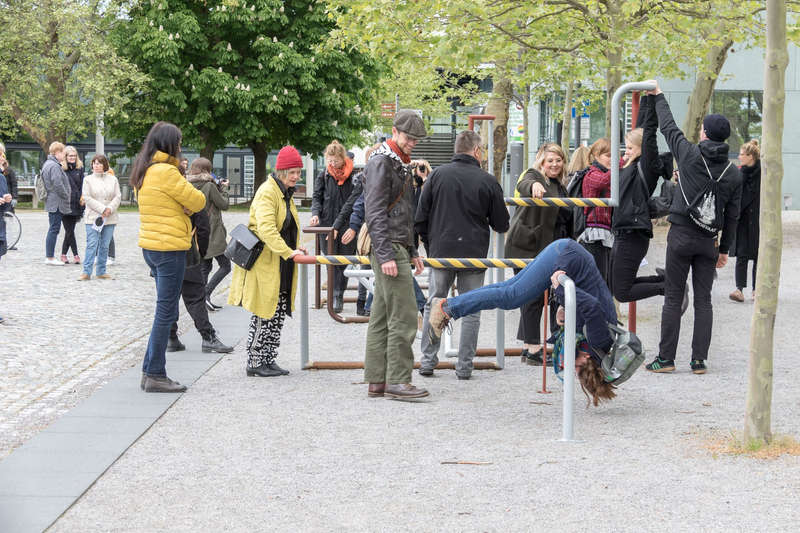
The first stop on Bauhausstraße interrupts the stroll, past a few old and many new buildings of the Anhalt University of Applied Sciences (FH) - Hochschule für angewandte Wissenschaften, so the correct name. But today's students say that they "study at the BAUHAUS". Located here are three large black rubber balls which can be touched and rolled to other places in order to change the perspective. At the seminar square, a line of molded steel follows the course of the road. Children use it as a jungle gym and visibly enjoy it. The more hesitant adults touch it and perceive different surfaces. Some areas are wrapped in tape, wound in metal, and are edged or round or notched. Unfortunately, during my visit, the audiovisual installation in the underpass of the main station only consisted of the visual area of the black-and-white lettering on the walls. The loudspeakers were still there, but there was no longer "pssst", "pschhhhht", and "pst’’ to be heard.
On the meadow in front of the main station there are two parallel walkways over which concave and convex highs and lows can be walked. This station can also be perceived as a traditional sculpture of high aesthetic value. The feeling of oppression is felt amid the narrow buildings of the Fürst-Leopold-Carré. You walk between black walls made of elastic fabric and, by pushing them aside, you are able to provide yourself with a little more space.
In front of the classicist façade of the Anhalt Theatre and a bust of Karl Marx, there are 12 flagpoles whose grey covering consists of a circle, a square, and a triangle. The flags fluttering in the wind transform the strict geometric forms into something more wild and untamed. The walk is interrupted one last time, this time by a rectangular trampoline which is parallel to the house bar on the lawn of Antoinettestraße. Jumping and hoping one relaxes instead of rushing by.
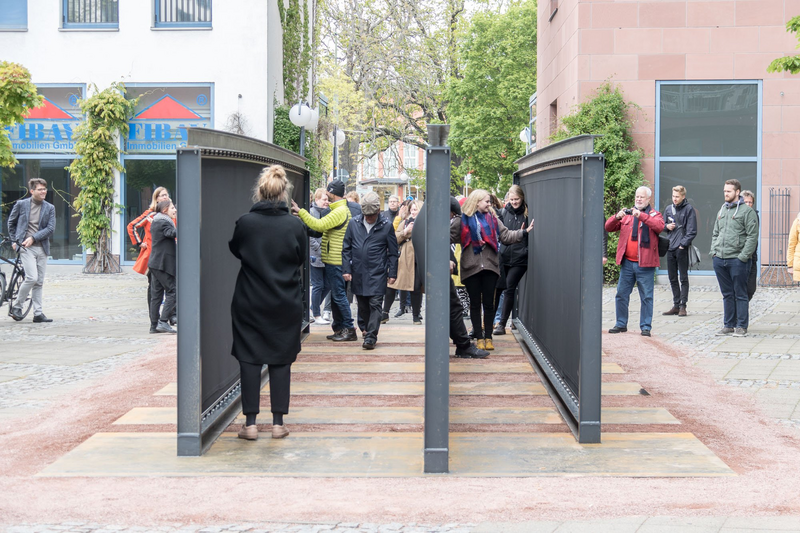
How can one communicate 100 years of BAUHAUS to visitors? On March 7, 1945, Dessau, a major armament and administrative center of Germany, was almost completely destroyed. How should one imagine the historical Dessau, which has completely changed its face after the reconstruction in the DDR? And on the other side: no law firm, no doctor's office that keeps up, without cantilever chairs and no private household without Corbusier couch. Formerly an alternative school of design that enjoyed experimenting and whose works today run under the label "Classical". The museum presentation of the BAUHAUS Museum is one possibility. The inclusion of the present place with the help of newly created rooms, inspired by the concepts of BAUHAUS creators, is another. Both can only be an approximation. What the designers from Dusseldorf have created here is fun. And if you think of the festivities mentioned above, it is clear that having fun through celebration and being creative was also an important part of BAUHAUS life, teaching, and learning.
Author: Ursula Karpowitsch

